Apple’s macOS and iOS include a built-in password management system called Keychain Access, which is supplemented by iCloud and allows for syncing the Keychain between multiple devices. This is a great and simple security solution for many users, but some users require more features in their password manager than iCloud and Keychain can provide, especially those in the enterprise space who need the ability to share passwords and other confidential information between multiple users.
Here is a look at the top products available to iOS and macOS customers to provide more features like password sharing, secure document storage, and more features that modern users demand from their security software.
Best password managers for macOS and iOS: comparison table
| Product | Star rating (out of 5) | Supported platforms | Supported web browsers | Active password monitoring | End-to-end encryption | Pricing |
|---|---|---|---|---|---|---|
| 1Password | 4.3 | macOS, iOS, Windows, Android, Linux, Chrome OS, command line | Safari, Firefox, Chrome, Brave, Microsoft Edge | Yes | Yes | From $2.99/month for Individual accounts and $7.99/month for Business accounts. |
| Dashlane | 4.6 | macOS, iOS, Windows, Android | Safari, Firefox, Chrome, Internet Explorer | Yes | Yes | From $4.99/month for Personal plans, $8/month for Business and $20/month for Starter |
| Bitwarden | 4.6 | macOS, iOS, Windows, Linux, Android | Safari, Firefox, Chrome, Opera, Microsoft Edge, Brave, Tor, Vivaldi | Yes | Yes | Starts from a Free plan, then $0.83/month for Personal plans and $4/month for Business plans |
| Keeper | 4.4 | macOS, iOS, Windows, and Linux, Android | Safari, Chrome, Firefox, Edge, Opera, IE | Yes | Yes | From $2.92/month for Personal and Family plans and $2 per user/month for Organizations |
| Enpass | 4.0 | macOS, iOS, Windows, Linux, Android | Safari, Firefox, Chrome, Microsoft Edge, Opera, Vivaldi | Yes | Yes | From $1.99/month for Personal and Family plans and $2.99/user per month for Business plans |
Best password managers for macOS and iOS
We’ve found the best password managers to safely secure your macOS and iOS devices.
1Password: Best overall
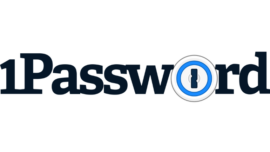
For my best overall, I recommend 1Password. 1Password has long been a password manager companion on macOS, upgraded with features over the years to make it one of the ultimate password companions.
1Password has end-to-end encryption that allows for full protection when syncing. Data synced through 1Password is secured by one password that you need to remember to unlock all of your passwords. In addition to clients for macOS, there’s also a client for iOS and a client available online to access your passwords and data remotely on a guest machine. It can synchronize notes, credit cards, software licenses, important documents, server logins, and SSH keys that can be accessed via the command line.
One of the standout features of 1Password is the ability to automatically check passwords securely against leaked password databases to alert you to any potentially compromised accounts.
When I tested out 1Password’s browser extension, it allowed me to autofill passwords, 2FA codes, and other details, as well as create accounts and store them right from the web browser. 1Password also allows for content sharing inside any vault with other users of 1Password or via links a user can click to view the securely shared item.
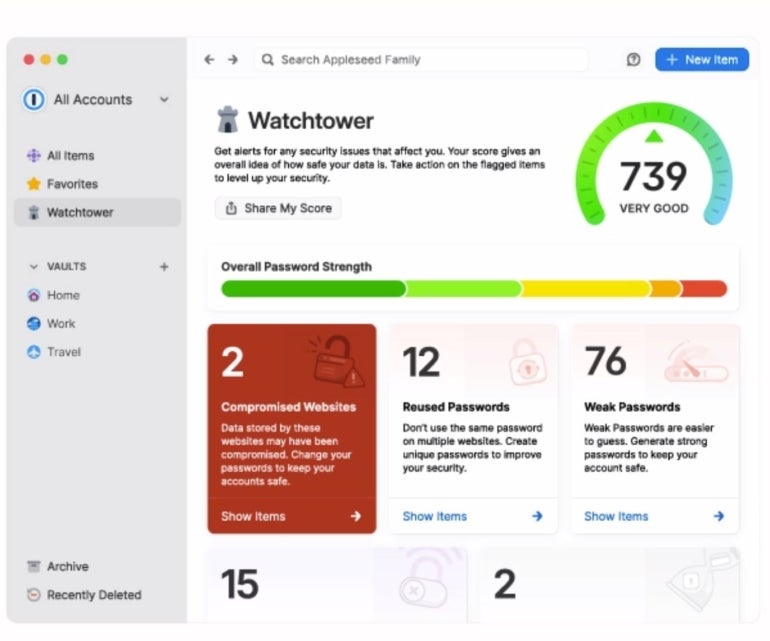
Why I chose 1Password
I picked 1Password as my best overall for its balance between security and user-friendliness. Amidst its sophisticated security features, the interface remains intuitive. In my view, adding a security breach alert feature through Watchtower and seamless integration with Mac and iOS devices makes it a great choice for those who demand the best of both worlds.
Features
On macOS:
- Secure password storage.
- Watchtower for web monitoring.
- Two-Factor Authentication (2FA).
- Browser extension for easy auto-fill.
On iOS:
- Face ID and Touch ID support for quick and secure access to passwords.
- Password auto-fill that works on iOS apps and Safari.
- Secure Notes for storing sensitive information like credit cards.
1Password pros and cons
| Pros | Cons |
|---|---|
| 1Password app integrates with Apple’s password auto-filling. | Offers no free plan. |
| It supports TouchID on the Mac for authentication and unlocking. | There is no phone or chat support for lower-level subscribers. |
| Integrates with the command line to allow SSH key filling. | |
| Supports security breach alerts through Watchtower. | |
| Supports Single Sign-On for easy login across all platforms. |
Pricing
1Password offers multiple pricing plans covering individual, business, and enterprise use cases, with options for both annual and monthly subscriptions. Below is a breakdown of its annual plans. All plans, except the Enterprise tier, come with a 14-day free trial.
- Individual: Starts at $2.99/month.
- Families: From $4.99/month for 5 users.
- Teams Starter Pack: From $19.95/month for 10 users.
- Business: $7.99/month.
- Enterprise: Based on quotes.
Dashlane: Best for security

If top-tier security is your priority, I suggest looking into Dashlane. Dashlane is a password manager that encrypts content on a device before leaving it (like the others above), but also offers other features not found in comparable password manager apps.
Notably, for enterprise users, Dashlane can be unlocked with MFA apps like Duo, making Dashlane more secure because users will not need to type in their vault password each time to unlock the app, allowing for a more secure vault password without the need to remember it.
Dashlane supports a limited number of data types and can store passwords, secure notes, and payment information with ease. Dashlane doesn’t offer more tailored vault types, like software licenses or encrypted documents and files. The app and service supports password sharing and account credentials with other users.
I personally like how Dashlane includes a Dark Web monitoring feature for detecting compromised passwords and accounts. In addition, Dashlane has a nifty feature that allows users to change passwords for breached accounts right from the app for supported websites and services.
Dashlane is not supported for Linux or Microsoft Edge (but support should be coming), so if those platforms are important to you, this might be a deal breaker for now.
Why I chose Dashlane
To me, Dashlane stands out for its user-friendly interface and security features. The VPN integration for added online security is a notable plus, and the real-time phishing alert and dark web monitoring keep users informed about potential breaches.
Features
On macOS:
- Improved autofill feature in the Dashlane Safari extension.
- Can retrieve generated passwords.
- Random password generator.

On iOS:
- Biometrics or PIN unlock in the iOS app.
- Dashlane authenticator app.
- Password Health tool.
- Voice control feature for the iOS app setup.
Dashlane pros and cons
| Pros | Cons |
|---|---|
| VPN for WiFi protection. | Log-in with SSO is only available on the Business plan. |
| Real-time phishing alerts. | 2FA can’t be turned on/off in the Dashlane macOS app. |
| Dark web monitoring. | Phone support is only available on the Business plan. |
| Keeps a complete password history. | |
| Unlimited password sharing. | |
| You can change the master password. |
Pricing
Dashlane offers three subscription plans: Personal, Business, and Enterprise.
Personal Plan:
- Premium: $4.99/month (Billed annually).
- Friends & Family: $7.49/month for 10 members (Billed annually).
Business Plan:
- Starter: $20/month for 10 seats (Billed monthly).
- Business: $8/month (Billed annually).
- Business Plus: $5/employee/month (Billed annually).
Enterprise Plan:
- Contact sales for pricing and availability.
Bitwarden: Best for developers
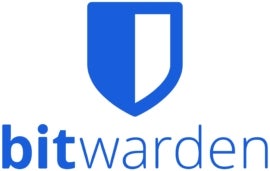
For developers and privacy champions, Bitwarden is my pick. Bitwarden is an interesting password manager because it is open-source. This means that the code you’re trusting your passwords and accounts with can be vetted by your organization (and the global security community) to help improve features.
Bitwarden supports most modern computing platforms, striving to provide access to most web browsers and operating systems.
The interesting bit about Bitwarden is that there’s a self-hosted version of the Bitwarden service that can be deployed in your organization instead of relying on Bitwarden’s paid cloud for syncing items. This can add peace of mind and additional security to your organization.
Like some other password managers, Bitwarden can be unlocked using MFA SSO (single sign-on) services like Duo, a great feature for password managers in the enterprise setting where MFA is the standard security policy.
For me, Bitwarden’s highlight feature is that it can keep track of shared vaults and who accessed what data and when for audit trails, and vaults can also have encrypted files added to them. When I used Bitwarden, the app alerted me about reused passwords, weak passwords, and other security metrics in a vault health report that also included any compromised passwords and accounts.
Why I chose Bitwarden
I selected Bitwarden because of its high performance and open-source features; the ability to store and share unlimited passwords across multiple devices, and its capacity to meet the needs of many users for free. I also think Bitwarden is an ideal choice for users seeking a free password manager with decent performance.
Features
On macOS:
- Command-line interface.
- Password generator.
- Bulk operations support.
On iOS:
- Biometrics logins.
- Customizable mobile app theme.
- Unlimited password synchronization across multiple devices.
Bitwarden pros and cons
| Pros | Cons |
|---|---|
| It’s open-source, which makes the codebase more transparent. | Auto-filling has occasional glitches. |
| Offers a free plan. | Only supports macOS 10.14 or later. |
| Provides reports on exposed, reused, and weak passwords. | Premium users only have 1GB of encrypted storage. |
| Multiple language support. | |
| Developers can leverage Bitwarden’s Passwordless.dev to build passkeys. |
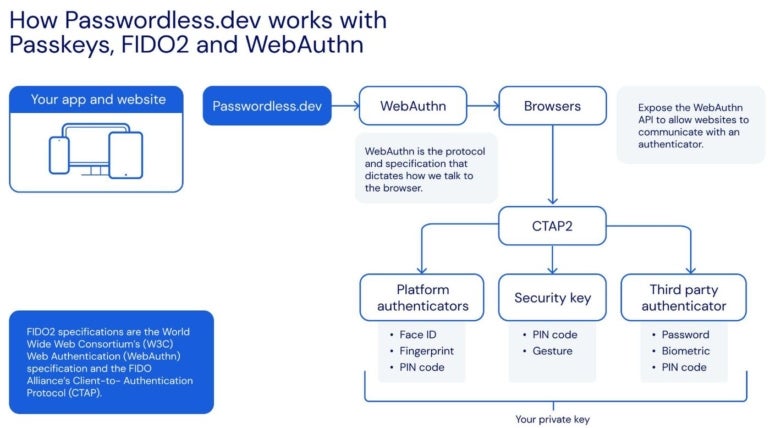
Pricing
Bitwarden offers Personal and Business subscription plans:
Personal Plans:
- Free.
- Premium: Starts at $0.83/month, billed $10 annually.
- Families: From $3.33/month, billed $40 annually.
Business Plans:
- Teams: $4/user/month.
- Enterprise: Starts at $6/month per user.
- Contact sales for a custom quote if you have hundreds or thousands of employees.
Keeper: Best for business users

For those interested in a business or enterprise-centric solution, I like Keeper. Keeper is a password manager who appears to be more geared toward business users but also has plans that give the same functionality to personal users. The things that set Keeper apart are the multiple layers of encryption at the vault level, shared folder level, and record level of the account — ensuring a zero-trust architecture.
Keeper can store passwords, payment information, and documents, but it also has personalizable fields, allowing for an infinite number of customizations on the data types that Keeper can store. In addition to these data types, I particularly like one of its features called “Keeper Secrets Manager.” It allows for the storage and secure sharing of infrastructure secrets such as API keys, database passwords, access keys, certificates, and any type of confidential data.
A Dark Web scan feature allows you to quickly be notified if your usernames or passwords appear on any stolen data drops online so that you can react and reset your accounts to ensure they don’t get compromised.
Why I chose Keeper
I went for Keeper due to its robust security and organization customization features. While it caters to the needs of personal users, my decision to feature it on the list stems from its unique offering for enterprise users.
Features
On macOS:
- Autofill and auto-type password features.
- iCloud Keychain import.
- TouchID for macOS v16.10.9s.
- Secret manager feature.
On iOS:
- Secure digital vault.
- Password generator feature.
- One-Time Share to share passwords with other non-keeper users.
- Supports two-factor authentication (2FA).
Keeper pros and cons
| Pros | Cons |
|---|---|
| Allows for easy customization of vaults. | Offers a limited free plan. |
| Secrets Manager feature utilizes zero-trust and zero-knowledge security for infrastructure protection. | |
| Offers visibility and control for easy password management, compliance, and reporting. | |
| Users can store an unlimited number of passwords. |
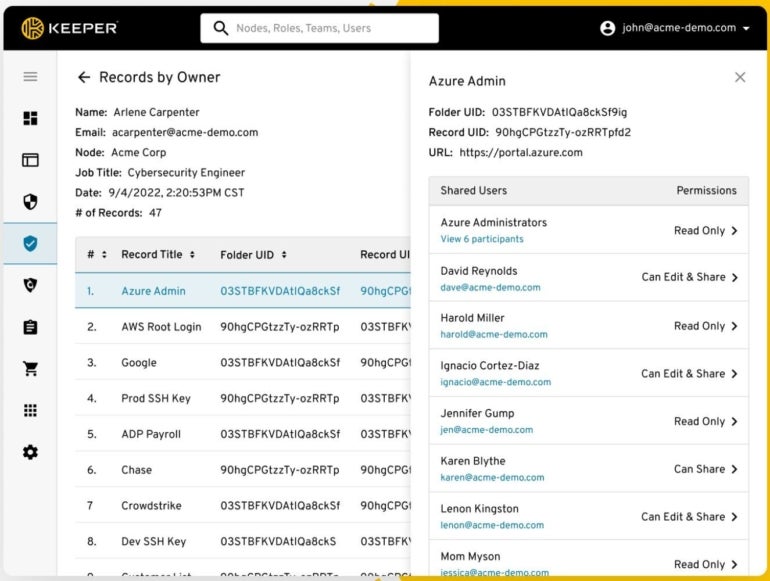
Pricing
Keeper offers two pricing tiers: Personal and Business. Let’s unbundle them below.
Personal
- Personal plan: Starts at $2.92/month, billed $34.99 annually.
- Family plan: From $6.25/month for 5 users, billed $74.99 annually.
Business
- Business Starter: From $2 per user/month, 5-10 seats.
- Business: From $3.75 per user/month, minimum of 10 seats.
- Enterprise: Contact Keeper for a quote, minimum of 10 seats.
Enpass: Best for local storage
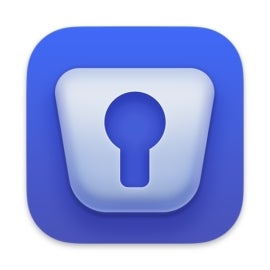
For users who want local storage of their credentials, Enpass is what I recommend. Enpass is a unique offering in the password manager space. Where most managers are creating their own syncing service, Enpass goes a different route by only storing passwords via an “offline” mode where they are encrypted on your computer. If you wish to synchronize passwords to other devices, then you must roll out your own solution through supported syncing platforms like iCloud, Dropbox, Google Drive, OneDrive, or your own WebDAV server.
Many users might prefer this model because it means that you know exactly where your passwords are being stored and can keep tighter control over the copies of your synced vaults. You can even choose to only sync your vaults via Wi-Fi for a completely “offline” model where your passwords never leave your network.
Enpass offers a feature that routinely audits your passwords and accounts to ensure they are strong (even after creation). It also checks if any of your account credentials were part of recent data breaches and that your accounts that support two-factor authentication have that feature enabled. It can also detect expired passwords for sites and services that require rolling passwords after a certain amount of time.
Even though Enpass has an “offline” model, I appreciate that you can still select from over 80 templates to store credit cards, passports, driving licenses, insurance documents, and more.
Why I chose Enpass
I opted to feature Enpass on this list due to its self-hosted password management feature and the flexibility it offers users to choose their preferred third-party syncing platforms like Dropbox, OneDrive, and Google Drive. Enpass is also one of my top choices for budget-conscious users who prefer their data to be stored locally and seek a one-time payment model.
Features
On macOS
- Local data storage.
- Ability to create custom tags.
- Create and manage multiple pre-loaded templates.
- Sync and access your passwords from anywhere.
On iOS
- Supports keyfile as second-factor authentication.
- watchOS integration.
- Sync and access data between devices.
- Face ID, Touch ID, and PIN unlock.
Enpass pros and cons
| Pros | Cons |
|---|---|
| Offers unlimited vaults. | The site’s load time is slow. |
| Automatic compromised password checker. | User-friendliness could be improved. |
| Offers a one-time buy plan. | |
| Supports customizable password generator. | |
| Auto-fills passwords, authentication codes, credit cards, and web forms. | |
| Centralized admin console for easy password management. |
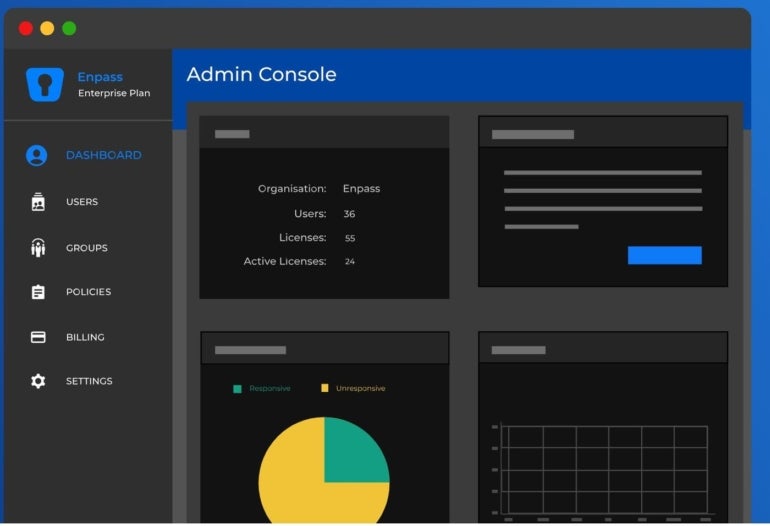
Pricing
Enpass offers Personal & Family and Business subscription plans:
Personal & Family
- Individual plan: From $1.99/month, billed at $23.99 annually.
- Family plan: From $2.99/month for the first year, billed at $35.99 annually, and subsequently at $47.99 annually.
- One-time plan: Pegged at $99.99 for a one-time purchase.
Business:
- Starter Plan: From $9.99/month for up to 10 users.
- Standard Plan: From $2.99/user per month.
- Enterprise Plan: From $3.99/user per month.
Why use a password manager?
Password managers have slowly become a necessity of modern internet and computer usage. In the past, more relaxed and simple password requirements meant that you could reuse a password on every account you had, but eventually, that became an issue, as when one account was compromised, all accounts could easily become compromised. This led to more complex security requirements for websites, and now two-factor authentication requirements as well, requiring not only a username and password to log in, but also a one-time password generated by a password manager.
Using a password manager means that your accounts can all be stored safely and securely in a single location, generating highly secure alphanumeric passwords for you on the spot. Without needing to remember these complex passwords, you can increase the security of your accounts by integrating hard-to-remember password incantations into your accounts, including numbers, special characters, and upper- and lowercase characters.
Most password managers include a setting to choose between easier-to-read (less secure) password generation and mixed alphanumeric and special character password generation (more secure).
SEE: Securing Linux Policy (TechRepublic Premium)
What features should you expect in a password manager?
A good password manager should be able to securely synchronize your usernames and passwords to all of your devices. It should also have a good web browser extension that can be used to automatically fill the passwords and save passwords to its database securely when registering new credentials on a website (and preferably offer up a strong password).
Additional items to look for in password managers are:
- Allow you to securely store notes — either random notes or notes attached to the accounts to document things for your online accounts.
- Allow saving credit cards and other payment details securely so they can be automatically filled out when checking out on a website.
- Active password monitoring so that accounts and passwords that have been compromised in recent website hacks are reported to you to change passwords for security purposes.
- Two-factor authentication support allows you to secure accounts that support 2FA and automatically fill in the one-time password when signing in with your username and password from the same app.
- Ability to securely share items from the password manager with team members, family members, or guests in the case of Wi-Fi passwords.
- Ability to store login credentials for servers, databases, and more.
When choosing a password manager, it can be very important to look at your needs and then evaluate which platform meets most of them. Security should also be a top priority: Pick a password manager platform with end-to-end encryption to ensure that your credentials are encrypted before leaving your device and being stored on their servers and that only you control the key to decrypt the vault.
Which password manager is the best?
It’s important to choose a password manager that encrypts your information when transmitting it to an online locker, offers multi-platform support, and works with multiple web browsers — after all, the browser you use today may not be the one you continue to use in the future. These are the distinguishing features of all password managers presented above, and you’ll need to choose what best suits your workflow.
Methodology
I compiled a review of the best password managers for Mac and iOS by conducting thorough research and examining the features offered by top password managers on the market. I also compared their pricing, advantages, and disadvantages before narrowing our list down to these five. Finally, I also used some password managers to better understand their suitability for different users and identify potential alternatives.
This article was originally published in November 2023. It was updated by Luis Millares in January 2025.